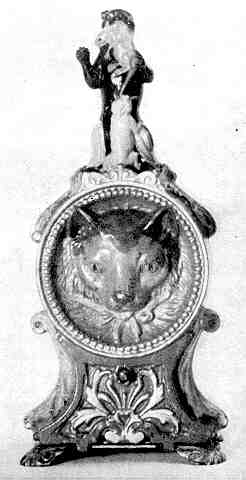Cat and Mouse Bank (Type I)
by F.H. Griffith - HOBBIES Magazine - May, 1976
 A little more catching up on an important Type bank is appropriate
at this point. As explained before, some Type banks have been left in limbo due to the
timing of the articles on certain mechanicals plus other factors, including mechanicals
that turn up now and then.
A little more catching up on an important Type bank is appropriate
at this point. As explained before, some Type banks have been left in limbo due to the
timing of the articles on certain mechanicals plus other factors, including mechanicals
that turn up now and then.
Going back to the Cat And Mouse Bank (HOBBIES, November 1964), we now know this bank as Type II. We have never given details on the Type I pictured which is a quite important very scarce bank with circumstances of its existence similar to those of the Called Out Bank, another scarce rare item. At this time, having no choice in the matter, the Cat And Mouse, Type I is No. 262 in the numerical classification.
Like the Called Out Bank, the Type I Cat and Mouse is in an undefined area as to how many may have ever reached any stage of general distribution. Also like the Called Out Bank, we know it was made by the J. & E. Stevens Company and that it was a bank entirely produced by them. There is no doubt that James Bowen who patented the Cat And Mouse was an influencing factor in the circumstances surrounding the Type I. It is a logical deduction that the Type I was Bowen’s initial version of the bank and that the somewhat gross subject matter of a rather fierce looking cat holding a mouse in its mouth in a well defined fashion was the beginning of the end of the bank. No doubt certain Stevens’ personnel, as well as Bowen, decided after production that the bank simply wouldn’t have great potential or popularity with the unpleasant subject matter involved. So at whatever point, the Type II replaced the Type I.
It is of interest to note that neither of the two types are just like Bowen’s patent of April 21, 1891. The patent drawings are, however, more similar to the Type II. This with particular reference to the figure of the cat and mouse. The large clock-like configuration of the overall bank is the same in both Type I and II, and in either case like the patent drawings.
Of interest too is the fact that the more widely known Type II has the figure of a cat and mouse made in cast iron, as is the rest of the bank. Not so with Type I — the figure of the cat holding the mouse in its mouth is brass. As we know from certain other mechanicals, brass was used as a part or parts where unusual strain, stress, or other factors were involved where cast iron (more brittle) would tend to break. There is no question but that the cat and mouse revolve into position with considerable force and obviously in the earlier Type I it was felt necessary to make it in this fashion. Subsequent testing and so on apparently bore out the lack of necessity of using brass for the figure and cast iron was more expedient for Stevens to use anyway.
Both Type I and Type II operate alike. A coin is placed on the platform in front of the single mouse. (This appears when the figure is pushed revolved back into position from that shown in the picture.) The lever in front, under the large cat face, is pressed down. On so doing the cat holding the mouse revolves and snaps rapidly into position as shown. The coin falls from the platform into a tapered funnel shape section and on into the coin receptacle base. Coins are removed by means of a conventional round Stevens trap in the bottom base plate.
Colors of the Type I, with one important exception, are the same as those used on the better known conventional Type II. The exception is the figure of the cat holding mouse. The cat on the bank pictured is an all over black and he has yellow eyes. The kitten holding on to the mouse’s tail is a yellow-tan color and it has white eyes. The mouse is gray with black eyes. The drapery around the legs and back of the black cat is red.
There is no question as to the rather unpleasantness of the representation of the subject matter on the Type I bank. Being objective about it, however, it is a very interesting mechanical and actually a quite rare desirable bank. To the best of the writer’s knowledge only three, possibly four, are known to exist.
